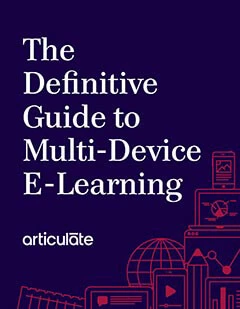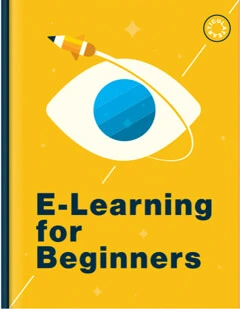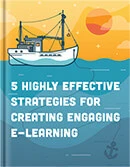Rise 360: How to Design an Accessible Course
Article Last Updated
This article applies to:
Creating accessible e-learning content isn’t just about meeting standards and requirements for a few learners. Enhancing accessibility benefits everyone, letting learners focus on your content without distraction and frustration. Keep reading to discover ways to boost accessibility and help all learners fully engage with your Rise 360 courses.
- Design with Accessibility in Mind
- Make Visual Content Accessible
- Make Audio Content Accessible
- Make Interactive Content Accessible
- Get Help When You Need It
Design Your Course with Accessibility in Mind
Accessibility doesn’t happen by accident. As a course author, you must make intentional design choices to let all learners—including those with visual, motor, auditory, speech, or cognitive disabilities—know they’re an integral part of your audience from the start.
Here are some helpful tips to remember as you design your course with accessibility in mind.
- Provide accessibility instructions upfront. For example, clearly explain crucial navigation options at the beginning of your course so learners tabbing through a course with a screen reader can navigate directly to lesson content and skip the sidebar navigation. Including a link to this article on keyboard-accessible navigation allows learners to familiarize themselves with alternate navigation in Rise 360.
- Stay consistent. When you use an object or interaction more than once, identify it the same way each time. For example, if you use button blocks to jump to other locations, label them consistently throughout your course.
- Give clear feedback. Use the feedback field for quiz questions and knowledge checks so learners know what to expect when they respond incorrectly.
- Make content safe for all learners. A flashing .GIF or intense video might provide some visual pizzazz, but it could also trigger seizures in people with photosensitive epilepsy. Don’t use videos or animations that flash or blink more than three times per second. If you’re not sure, use this tool to analyze your video.
- Use plain language. Your content should be straightforward and easy to understand. Plain language is crucial for non-native speakers and those with cognitive disabilities, and it helps all learners comprehend the material more effectively.
- Use descriptive links. Instead of a vague phrase like "Click here," use something specific like "Read our policy statement," so learners know where the hyperlink will take them.
Make Visual Content Accessible
Visual disabilities cover a wide spectrum, including low vision, color blindness, and total blindness. Learners who find it difficult to read on-screen text due to learning disabilities or because the course language is a second language for them can also be included in this category.
While making a visual medium like online coursework accessible can seem daunting, it’s actually not too hard once you get some basics in place. Let’s break it down by specific accommodations.
Screen Readers
Learners often use screen readers to experience e-learning courses. Rise 360 supports JAWS, NVDA, VoiceOver, and TalkBack screen readers with our supported browsers. Here are some accessibility best practices for creating screen-reader-friendly content.
- Provide text-based alternatives. Important information should be conveyed with text blocks rather than imported text images since assistive tools can’t read images.
- Identify the course language. Screen readers use the course language you set in your text labels to determine how to pronounce the interface elements and course content.
- Use tables. Tables organize your content visually and communicate how it is organized to screen readers, providing context to the learner. Learn more about adding tables in Rise 360.
- Use headings and labels. Like tables, heading blocks and content labels do more than just organize your course. Breaking long sections of content into discrete, clearly labeled parts helps many types of neurodivergent learners. They also make navigation easier for learners using screen readers.
Contrast Ratio
Rise 360 interface elements already meet minimum contrast requirements, but you’ll want to ensure your design choices also follow these guidelines. If you’re uncertain, here’s a helpful contrast checker to determine your contrast ratio. The following best practices can help you apply what you learn.
- Ensure a contrast ratio of 4.5:1 or higher for text. This ensures that learners with low vision can read it.
- Don’t depend only on color cues. Learners with color blindness might not see the differences in your color choices, so provide alternatives when color is used to convey important information or instructions. Use a 4:5:1 contrast ratio between normal-sized clickable text and static text (3:1 for large text), and consider using patterns, textures, or text to make different areas of an image—like the bars of a chart—stand out.
- Ensure a contrast ratio of 3:1 for non-text content. Be sure your Rise 360 accent color and block background color have a 3:1 contrast ratio or higher when adjacent to non-text content, such as buttons, charts, and other graphical elements.
- Differentiate between text and background images. If you use text on an image, set the image opacity so learners with visual disabilities can differentiate between text and background image. Also, keep a close eye on the image-to-text contrast ratio for graphics such as buttons. Graphics should have at least a 3:1 contrast ratio for large text and 4:5:1 for normal text.
Text Descriptions
When adding any visual element to your course, remember that learners who can’t see it need a way to get the information it conveys. Here are some best practices.
- Provide alternative text. Learners should have text-based alternatives for non-text content. Alternative text (alt text) can be used to describe images and text blocks or labeled graphic blocks to provide expanded descriptions of complex images like charts and maps. For audio and video blocks, use the caption field to describe the purpose of the media.
- Make alternative text meaningful. For images, clearly describe what’s being shown. Adding alternative text is easy in Rise 360. Our on-demand webinar, How to Write Alt Text for E-Learning, offers more specific strategies.
- Use accessible fonts. Use plain, sans-serif fonts, a minimum font size of 12 points, standard capitalization, sufficient color contrast, and bold for emphasis. For left-to-right languages like English, align text to the left.
Make Audio Content Accessible
Accessible audio content helps everyone fully engage and understand your content, especially learners who can’t hear. Here are some tips on making your audio content accessible.
- Add closed captions. Closed captions provide a text version of spoken words, making audio content accessible to those who can’t hear, whether due to hearing loss or being in a noisy place. (Note: Rise 360 doesn’t currently support captions for audio blocks.)
- Provide a transcript. A transcript gives a text-based version of the audio. Use a text block or an accordion interaction with a single tab to display a transcript.
- Include audio descriptions. If your course has videos, add text-based descriptions of visual elements in a text block. You can also create audio descriptions in a separate app and import them into Rise 360.
Make Interactive Content Accessible
Interactive blocks can be great tools for learning reinforcement, but making them accessible can be challenging. Sometimes, fully accessible interactive blocks just aren't possible. If you use interactive blocks, ensure the content is presented in other ways. Here are a few tips that will help you make your interactive blocks more accessible.
- Provide clear labels and instructions. Except for the sorting activity block, Rise 360 provides instructions for interactions. Until this interaction is fully accessible, use a text block to provide instructions.
- Don’t depend only on color cues. Relying solely on color to convey meaning can exclude learners with color blindness or low vision. Include text, audio, or image equivalents to help all learners fully engage with and understand your content.
- Allow flexible timing. Quiz timers can add unnecessary stress to the learning environment. Avoiding timers in your course allows learners to work at their own pace, giving everyone, including those with disabilities, ample time to use accessible alternatives and complete tasks.
- Include clear tips and error identification for quiz questions. Place concise instructions and feedback in prominent locations near quiz questions. Providing clear feedback helps learners identify and correct input errors.
Our ultimate goal is for authors to be able to create content without worrying if individual components are accessible and for Rise 360 content to be accessible to all learners—no exceptions. As we work toward that goal, we recommend checking out this guide to choosing accessible content components for more information.
Get Help When You Need It
Want to go deeper? Check out our Rise 360 Voluntary Product Accessibility Template® (VPAT®), explore our All About Accessibility series, Accessibility Index, and webinars on accessibility.
And when you need help, just post a question on E-Learning Heroes, the world's largest, most engaged e-learning community. There are over one million members eager to help. Chances are someone has already worked through a problem you’re experiencing and will have wisdom to share.


